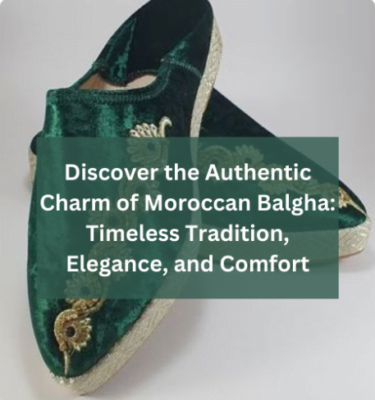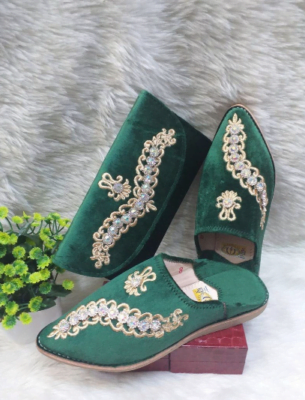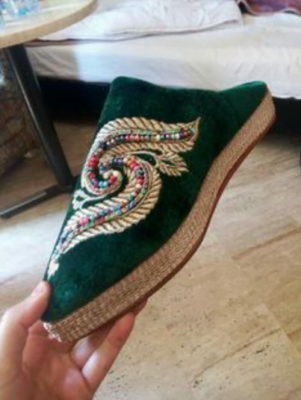Moroccan balgha is a leading brand in the fascinating world of Moroccan footwear because of its unmatched fusion of artisanship and cultural heritage. These classic shoes are more than just stylish shoes; they are priceless pieces that capture a way of life that has changed through time and become woven into Morocco’s rich cultural heritage.
Here, we explore the background, tradition, and artistry of Moroccan Balgha, one of the most well-known shoes that still has an impact on fashion today. Balgha are a symbol of Morocco’s rich artistic and cultural traditions and go beyond merely a particular type of shoe. Moroccan Balgha continues to be a famous representation of Moroccan workmanship and culture because of their ageless appeal and enduring comfort.

Origins and History of moroccan balgha
Originating in Berber and Arab customs, Moroccan Balgha developed over time to satisfy shifting demands as a reaction to the needs of Maghreb residents. Made using regional materials and artisanal skills handed down through the centuries, they offered toughness and endurance in trying circumstances. Balgha are a sign of Moroccan identity and culture that have been shaped by many different ethnic groups and geographical areas. They represent tradition while embracing modernity.
Features of moroccan Balgha: Crafting Tradition and Regional Variations
The materials used in its construction, their traditional design, and the regional differences all contribute to the distinctive qualities that set Balgha apart.
- Materials Used in moroccan Balgha Manufacturing: Balgha, which is typically manufactured from locally produced natural materials like wool and leather, is breathable, flexible, and durable; leather is the favored material due to its toughness.
- Traditional Design of Moroccan Balghas and Their Distinctive Features: Typically made from a single piece of leather or cloth stitched to the sole, balghas are noted for their simplicity and functionality. They are slip-on shoes with no laces or zippers that have an unusually upturned and rounded toe for additional protection and freedom of movement.
- Regional Variations in Styles and Patterns: Moroccan batiks exhibit a wide range of designs and patterns, with local variances in geometric patterns, hues, and vibrant embroidery that are indicative of handicrafts and cultural influences.

The Role of Balgha in Moroccan Culture
- Special Occasions Where Moroccan Balghas Are Worn: Wearing balghas at weddings, religious events like Eid, and other festivals is a custom that is strongly ingrained in Moroccan society. These events provide a chance to uphold cultural links and demonstrate respect for customs. Both brides and grooms frequently wear traditional clothing, replete with beautifully crafted balghas, as a statement of grace and cultural heritage at weddings. Similar to this, families dress traditionally, especially in balghas, during religious holidays like Eid as a sign of respect and joy. Additionally, wearing balghas is a chance to commemorate Moroccan culture and show pride in its rich customs on other celebratory occasions like family get-togethers and community activities.
- Cultural and Social Symbolism of Moroccan Balgha: In Moroccan culture, Moroccan Balgha are deeply symbolic of social standing, national identity, and cultural pride. They are typically saved for important events or highly regarded people.
- Significance of Balgha in Maintaining Moroccan Cultural Identity: Balgha are essential for maintaining and advancing Moroccan cultural identity because they are representative objects that uphold the authenticity and depth of Moroccan heritage, fortify ties within communities, and pass traditions down through the generations.

The Impact of Balgha on Contemporary Fashion
- Growing Popularity of Balgha on the International Fashion Scene: Once exclusively traditional Moroccan shoes, Balgha has become increasingly famous in the world of fashion because of its distinctive style, cultural significance, and artisanal craftsmanship. This has attracted the attention of fashionistas around the globe who are looking for genuine and one-of-a-kind products.
- Designers and Brands Incorporating Balgha into Their Collections: In order to increase Balgha’s adaptability and raise their profile in the fashion industry, well-known designers and fashion labels have included them in their collections and featured them on ready-to-wear lines as well as haute couture runways.
- Evolution of Balgha Styles to Meet Current Trends: Balgha has evolved to align with current trends, with designers experimenting with innovative materials, embellishments, and silhouettes to offer fresh interpretations, ensuring their relevance in today’s diverse fashion landscape while maintaining their classic charm.
Balgha has had a tremendous influence on modern fashion, rising above its traditional origins to become sought-after items on a global scale. Its enduring appeal is highlighted by its popularity, incorporation by designers, and adaptation to suit current trends. Balgha shoes, which have evolved to be significant in today’s fashion scene, are essentially representations of Moroccan workmanship, history, and custom that date back generations. They serve as expressions of pride in the country’s cultural heritage. Beyond just shoes, they stand for Morocco’s history, culture, and future, guaranteeing that their legacy will live on for many more years.


